.jpg?XrW8wYMN.TWqf8Su6ZyuXHm4DGqazGkT) This or That? Common Puppy Training Pitfalls and How to Avoid Them
This or That? Common Puppy Training Pitfalls and How to Avoid Them
You may have been following along the Journal of Miss Hedy Pawmarr, but if not...here’s the TL;DR ~ a new puppy just joined our family (the absolutely PAWdorable Boston Terrier puppy seen in this post) and the timing (right before Christmas) and the circumstances (pandemic, toddler, new house, hand surgery, running a business) meant that I needed to call in reinforcements to help control the chaos!
So I enlisted the help of my good friend, Robin Bennet, dog training guru, to help me (and I’m also using her terrific online course, Raising Your Puppy).
Now, I’ve raised puppies before, but I’ve made mistakes along the way...like...a LOT of them. I am determined this time to not fall prey to those pitfalls (Ha! Too late!), and so I’ve asked Robin to help us build a “Do This, Not That” guide of the mistakes most common in puppy training (at least if your name is Lorien). So without further ado...
Where should my puppy sleep at night?
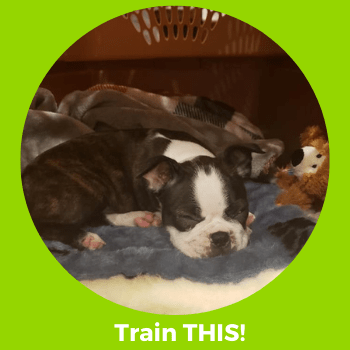
Puppy ALWAYS sleeps in the crate at night, preferably in the same room as you until housetraining is 100% successful
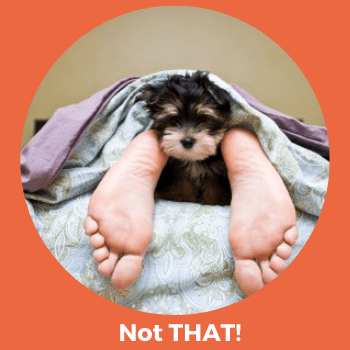
Allowing puppy to sleep in your bed, on an unsecured dog bed or in an isolated room away from you (outside of a crate) during the first months (prior to successful housetraining)
Robin tells us why
The first few nights are the hardest and humans are hard-wired to be sympathetic to cries from the young, but you need to set the puppy up for success. Before bedtime, make sure you tire them out and let them fully explore their new space (with supervision) the first few days they are home. Make sure they’ve had time RIGHT before bed to go potty. Also, ideally, all day long during the first day, you should work on familiarizing them with the crate -- tossing treats in to let them explore and leave as they wish, so they don’t fear the crate, but they see it is a safe place to be (with treats!).
At bedtime, you want to have a piece of fabric from the breeder or shelter that smells like the littermates, and/or something warm like a hot water bottle. Have the crate close your bed, so it is easy to stick your fingers in so they know you are near. The first few days, you are likely to get a bit of crying, but it is critical to tough it out so the puppy feels comfortable and secure in their crate, and critical life skills that they can be alone and cope. Petmate makes excellent high-quality crates aimed at creating a safe and relaxing space for your pet at bed time or when you leave the house and they need to be created.
How should I train my puppy not to bite?

Yip and pull your hand/body part away dramatically OR (if possible) redirect the puppy to a chew toy when they nip at you
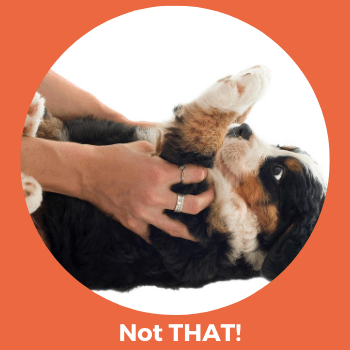
Flip over dog to show your dominance (“alpha rollover”) or in anyway scold or punish them for nipping
Robin tells us why
Dominance or disciplinary training for nipping and biting only trains the dog to (1) hide behavior that might otherwise be a warning that they are unhappy and thinking of biting, or (2) that they just can’t bite and nip YOU. With those techniques you aren’t teaching them what TO DO, but rather what not to do.
Puppies explore the world with their mouths. Loud noises and pulling away, and even leaving the area will reinforce the idea of “oh, the playing and fun stops when I bite,” which is how their littermates would react in natural play (they yip and then move away). Puppies that are teething have sore gums that are craving to chew, so it is a good idea to have chew toys near to “replace” your body parts from chewing!
How do I get my puppy to "mind" (and respect) me?
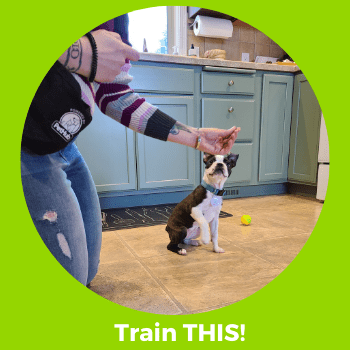
Reinforce positive, desired behaviors with tasty treats like these praise and attention and, if needed use generic high pitch sound, hand clap or rattle sound to distract dog doing a really undesirable behavior
Robin tells us why
It’s all about building relationships. Yelling at anyone or being pushy isn’t good for relationships. Would you want to hang around someone that flipped you over on your back or yelled and disciplined you all the time? Probably not, it would certainly not be a relationship built on mutual trust, respect and admiration, but rather one based on fear.
Anything hurtful or emotionally hard for the dog isn’t a good way to build the relationship, so always keep that in mind. There are so many ways to “get the job done” that won’t hurt your relationship with your dog, always opt for positive reinforcement techniques.
How do I train my puppy not to jump up on people?
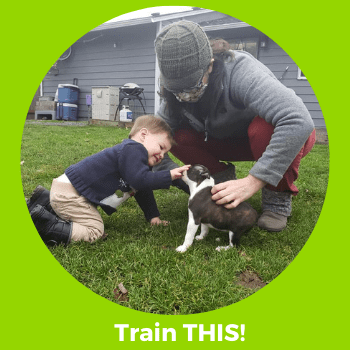
“Four on the Floor” before any petting or attention
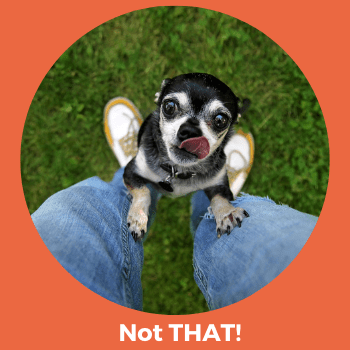
Petting or paying attention to a puppy who is putting their paws on you or jumping up
Robin tells us why
Getting this one “right” is really the basis of ANY thing you are doing with your puppy: If the dog does anything and it’s followed by something the dog likes, whatever they were doing just prior to that is going to continue.
So if they jump up or put their paws on you (and every puppy in the world is adorable when they do it), and then you pet them, or worse, pick them up and cuddle them... well, they really enjoy that and they just learned jumping up or pawing you is the way to get that.
It is so benign when they are tiny, but as they get bigger, one of three things will happen:
(1) They are tiny all their lives, and then they start to have to get “air” and jump really high -- Bostons do this!
(2) Bigger dogs will have a habit of jumping on people to get their attention and affection, which is annoying at best.
(3) And REALLY big dogs can actually cause bodily harm and knock you over when they jump up.
So you really have to think about what behavior will be acceptable when they are fully grown -- and that’s not likely to be jumping up. Go for the general rule of “all four paws on the floor” or even a full “sit” before the dog gets pet or picked up. Ignore them otherwise. It’s best to actually turn your back on that behavior, or leave the area if you can, so they really get “when I jump up, I don’t get anything fun or pleasing.” But the moment they have all four on the floor or sit, lavish them with praise and cuddles.
How do I keep my puppy from running away when it's time to come inside?
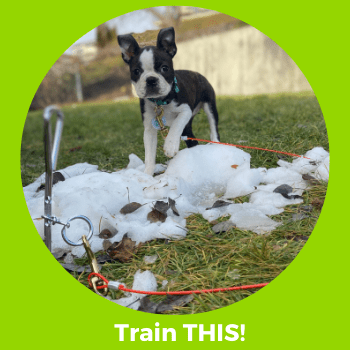
Use a long line like this one (15-20’) in the backyard during potty breaks and practice “come” in ways that don’t always mean “playtime ends” when you struggle to get your dog to come inside when they need to
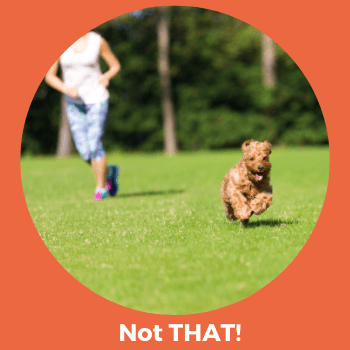
Chase your dog to get them to come in/stop behavior or train “come” to mean that puppy has to come inside (e.g. outside funtime ends)
Robin tells us why
Before they have really had a chance to learn a true “recall” command, it’s best to manage the situation by having your puppy on a long line or leash, especially if it's dark out and you literally just want her to go out to the bathroom and come back in.
If the puppy doesn't go to the bathroom, you can at least stop her from running by stepping on the long line and practice the recall (bring treats to all potty breaks for training opportunities!).
The other thing is to really make sure that when you are calling her it doesn't always mean her fun ends. That's probably the biggest reason that most puppies will figure out, “Oh every time they call me and I'm outside, I gotta go in and I don't want to do that.” So do a lot of games where you're calling your puppy and give her lots of treats and praise. Then you let her go play again out in the yard so it doesn't become a signal of all the fun ends.
How do I get my distracted puppy to listen to me?
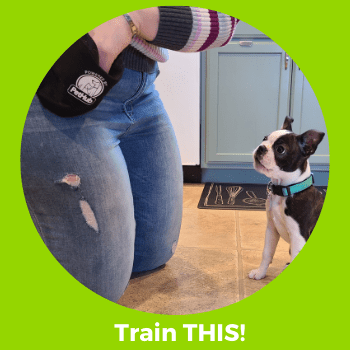
Say a command and pause for a 2 or 3 count and then try again, and if, after repeating, they still aren’t getting it, it may be too hard, so you need to lower expectations and do something easier
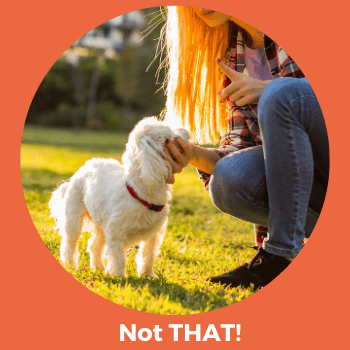
Repeating command over and over if they are not “getting it” and scolding them for not doing desired behavior
Robin tells us why
A lot of training is about making sure that you are setting the dog up for success. Dogs don't generalize very well, so if you train, let's say in the kitchen, they'll learn to sit really well in the kitchen with no distractions.
So by gradually adding in distractions (difficulty) you will be setting them up for success. If your puppy isn’t responding, and you have to repeat the command, pause and count to two or three seconds. If you really think the dog is blowing you off, I would also make sure she realizes she loses the chance for reinforcement.
For example, if you have a dog who gets overly excited and out of control when the leash comes out, drop the leash and walk away. All of a sudden your puppy will realize, “Wait a minute, I don't know what happened but I just lost the chance to go outside.” Do that consistently, and they will learn they have to stay calm to get to go out on the leash. Same with training. If you have treats in your hand and they aren’t paying attention during training, you put the treats away. Training (and treat opportunity) session ends. She will quickly learn that her opportunity to get treats depends on her listening to you.
How do I protect my puppy from hurting themselves with high furniture?
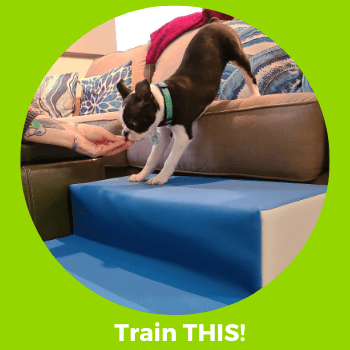
Give small dogs/puppys a way to safely climb up on “allowed” higher furniture (beds, couches) so they will not be as inclined to jump and injure themselves. For example, Petsafe makes a wide-range of doggy steps and stairs that can be found in their pet mobility sections.
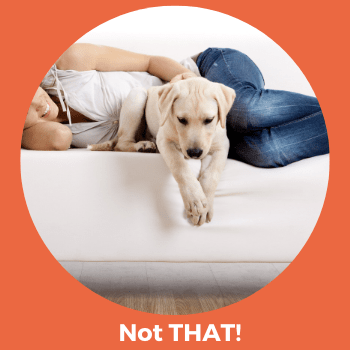
Place puppies (especially smaller ones) on high furniture and allow them to jump, or fall (or, worse, train) them to jump down
Robin tells us why
Some puppies (like Boston Terriers!) are fearless, and if you put them up on something high, they are likely to immediately think, “Whoo! I’m gonna jump off this thing!” and likely hurt themselves unintentionally.
You’ll have other types of dogs that will be afraid of things like heights, and putting them up high as a puppy reinforces that fear if they fall off. The more wriggly the puppy, the more risk of injury.
So I recommend not putting young puppies up on anything they could potentially fall or jump off of and hurt themselves.
You can use the opportunity to teach your dog several things: safe entry and exit from furniture (like with a small step) and also that they need permission to get up on furniture, as well as teaching them to respect the command to get down off of the furniture. Teaching proper “furniture rules” to your puppy will pay off greatly when your dog is older.
In addition, children should always handle puppies on the floor to reduce risk of a wriggly puppy falling or jumping and resulting in subsequent injury.
How do I keep my puppy from chewing up all of my stuff?
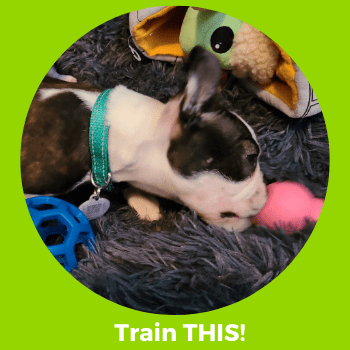
Provide constant supervision with ample variety of puppy chewing appropriate toys. P.L.A.Y and Patchwork Pet both offer a variety or both indoor and outdoor toys that are sure to catch your pet’s attention. PupPod is another great option for tech-loving pet parents, the PupPod always you to play with your dog remotely anytime-anywhere! For pets chewing and playing with items they shouldn’t be, immediately redirect them to these when they chew on non-toy items (like your favorite shoes).
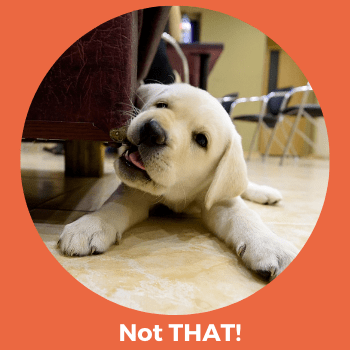
Allow puppies “free roam” of the house where they can potentially chew on non-chew toys without opportunities for redirection
Robin tells us why
The biggest thing about teaching your puppy proper chewing etiquette is supervision, supervision, supervision. It's not just enough for them to be in the same room, you have to actually know what they're doing in that room. They are going to chew on the wrong stuff sometimes because they have no idea and that's part of what they're learning as a puppy.
Make sure that you have a variety of things available that they are allowed to chew on. Also, choose smaller puppy toys that are a little more pliable that they can bite into. A lot of times, what seems like random chewing on anything they see is teething and so they do need something to relieve the pain in their mouth. I'm a big fan of two toys that you can soak in broth and then freeze. Also, choose smaller puppy toys that are more little more pliable that they can bite into. Now, when you catch them when they're chewing on the wrong thing, firmly (but calmly) tell them, “No” and immediately offer them something appropriate, “This is yours for chewing”. If you have a really persistent spot, like a rug or the baseboards or some spot where they're just relentless, use a bit of pet safe bitter-tasting spray as a deterrent. Now, for most dogs, that will be enough deterrent, but for some, they will chew through the bitter taste (they may even LIKE it) and you simply have to be vigilant about supervision and redirection.
How do I help my puppy learn to like grooming, teeth brushing and other activities that involve handling?
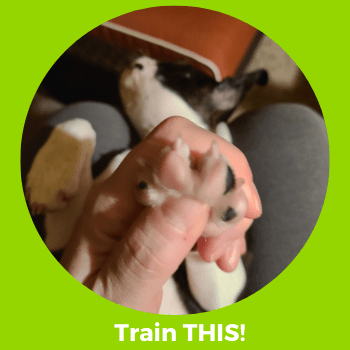
Play handling games nose-tip to tail 2-3x a day with a tired, relaxed puppy, using treats and lots of cuddly, positive reinforcement to get them used handling they will experience at vet, groomer and with you (like brushing teeth)
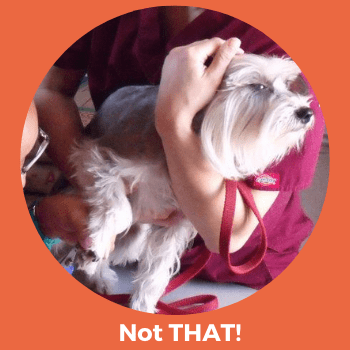
Waiting to let “professionals” handle your dog or putting off rituals like daily teeth cleaning, brushing, bathing, nail care, etc. until they “really need it” can be a recipe for life-long anxiety and even aggression with handling
Robin tells us why
Tip to tail handling needs to start as soon as you get your puppy. You are getting her prepped for the fact that you, vets and groomers are going be in her mouth, under her tail, touching her toes, looking in her ears.
So every day, do as much positive handling as you can. Using the puppy’s kibble, make it part of the feeding, “Okay, puppy, you're going to get this food, but we're going to do it during a vet check.” Pick up their ear and look in it. Give him some kibble. Pick up their paws, rub them, touch their nails, get your face close to them. And as you're holding their paws, give him treats (his kibble) so you're basically associating all that handling with something good. Same thing with the mouth, head, tummy, under the tail.
But the basic thing is you just sit the puppy in your lap, and a perfect time to do it is when they're already tired. They're not going to struggle a lot because they're tired. Eventually you introduce some tools, clippers or a Dremel, or a toothbrush for teeth -- but you just put it in your hand while you're handling the dog and giving kibble, so they start to associate all of that with positive experiences. Be slow to introduce the actual acts of clipping or tooth brushing, and always associate it with positive, enjoyable experiences for the dog.
This post is part of the Bringing Hedy Home series which chronicles the journey of bringing a new puppy into your life. In this series, PetHub's COO, Lorien, shares all of the joys (and terrors) that come with sharing your home with a puppy and provides some of the lessons she has learned in her lifetime of being a pet parent.
This post features insights from Robin Bennett, from The Dog Gurus and instructor of the Raising Your Puppy course. Raising Your Puppy is the ultimate, online, video guide to your puppy’s first 6 months is designed for busy pet parents and their newest bundle of joy. Break through the chaos of puppyhood and get your puppy started off on the right paw in just 10 minutes per day. Sign up today!



